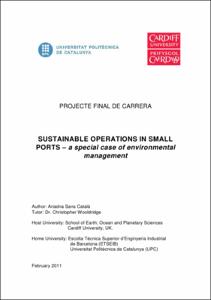Mostra el registre d'ítem simple
Sustinable operations in small ports– a special case of environmental management
| dc.contributor | Wooldridge, Christopher |
| dc.contributor.author | Sans Català, Ariadna |
| dc.date.accessioned | 2013-01-31T17:41:27Z |
| dc.date.available | 2013-01-31T17:41:27Z |
| dc.date.issued | 2011 |
| dc.identifier.uri | http://hdl.handle.net/2099.1/16988 |
| dc.description.abstract | Ports are, centres of life and progress not only for the town they belong to, but also for the entire area they influence. Regardless of the type of activity practised there, a port is movement, exchange, dynamism, and wealth. In order for all this to be possible, a port’s installations, infrastructures, and services must keep up with current needs so that the port remains vital. However, the existence of the ports always implies an environmental impact on water, air or soil. One of the most important challenges on the port sector is find the situation in which the port is able to meet its own needs without endangering its own future. Over the last years the port sector has demonstrated a positive and pro-active response to its environmental liabilities and responsibilities through the development of tools and methodologies developed specifically to deliver appropriate management options8. The first environmental management initiatives in ports areas began with the European Sea Ports Organisation (ESPO) on 1993 as a response to the need of European ports to be represented in Europe. ESPO’s mission is to influence public policy in the EU in order to achieve a safe, efficient and environmentally sustainable European port sector. Over the years, there has been increasing evidence that ports that adopts environmental management systems (EMS) for their operations can realize significant benefits as: · Minimization of environmental impacts · Demonstrate compliance with legislation · Reducing costs with the efficient use of recourses · Maintain a good public image However, there are multiple possibilities of response, from just compliance with legislation to archive high standards of environmental protection. Many ports, simply using an EMS system to evaluate and develop an effective environmental management program will be sufficient based on available resources or activities at the port. However, some other ports may decide that they need to use, and possibly become certified as in compliance with specific EMS, such as ISO 14000 or EMAS. It is a fact that all ports are unique; they vary in size, commercial activities, location, cargo handled, organizational structure and regulation. However, the environmental challenge is common for all, regardless of size. Then, the question is, is one management system suitable for all ports? |
| dc.language.iso | eng |
| dc.publisher | Universitat Politècnica de Catalunya |
| dc.publisher | Cardiff University |
| dc.rights | Attribution-NonCommercial-NoDerivs 3.0 Spain |
| dc.rights.uri | http://creativecommons.org/licenses/by-nc-nd/3.0/es/ |
| dc.subject | Àrees temàtiques de la UPC::Desenvolupament humà i sostenible::Política i gestió ambiental::Sistemes de gestió ambiental |
| dc.subject | Àrees temàtiques de la UPC::Nàutica::Infraestructures portuàries |
| dc.subject.lcsh | Harbors -- Environmental aspects |
| dc.subject.lcsh | Environmental management system |
| dc.title | Sustinable operations in small ports– a special case of environmental management |
| dc.type | Master thesis (pre-Bologna period) |
| dc.subject.lemac | Ports -- Aspectes ambientals |
| dc.subject.lemac | Sistemes de gestió mediambiental |
| dc.rights.access | Open Access |
| dc.audience.educationlevel | Estudis de primer/segon cicle |
| dc.audience.mediator | Escola Tècnica Superior d'Enginyeria Industrial de Barcelona |
| dc.audience.degree | ENGINYERIA QUÍMICA (Pla 2000) |
| dc.description.mobility | Outgoing |


